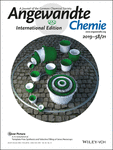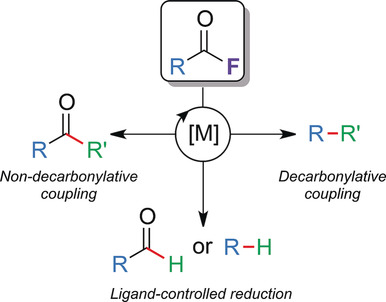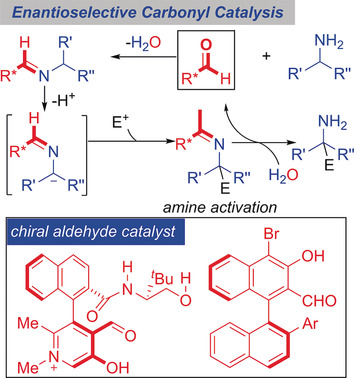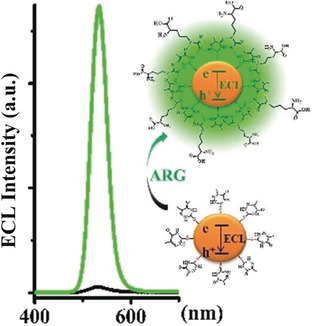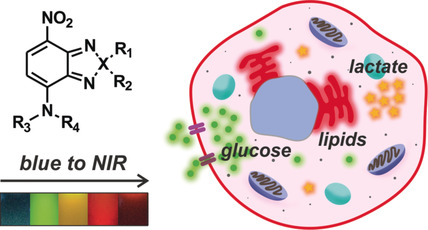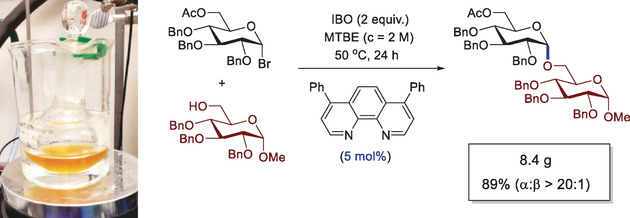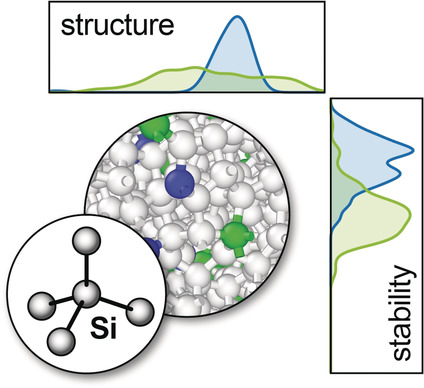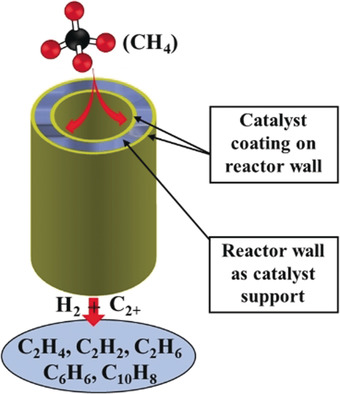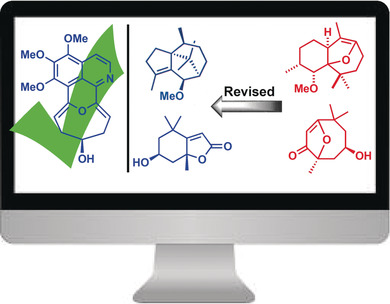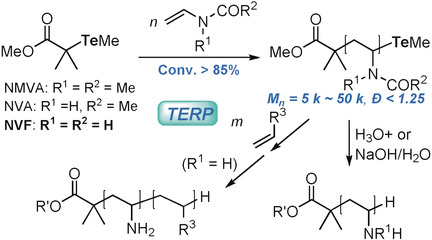Journal list menu
Export Citations
Download PDFs
Cover Pictures
Cover Picture: Template-Free Synthesis and Selective Filling of Janus Nanocups (Angew. Chem. Int. Ed. 21/2019)
- Page: 6783
- First Published: 15 April 2019
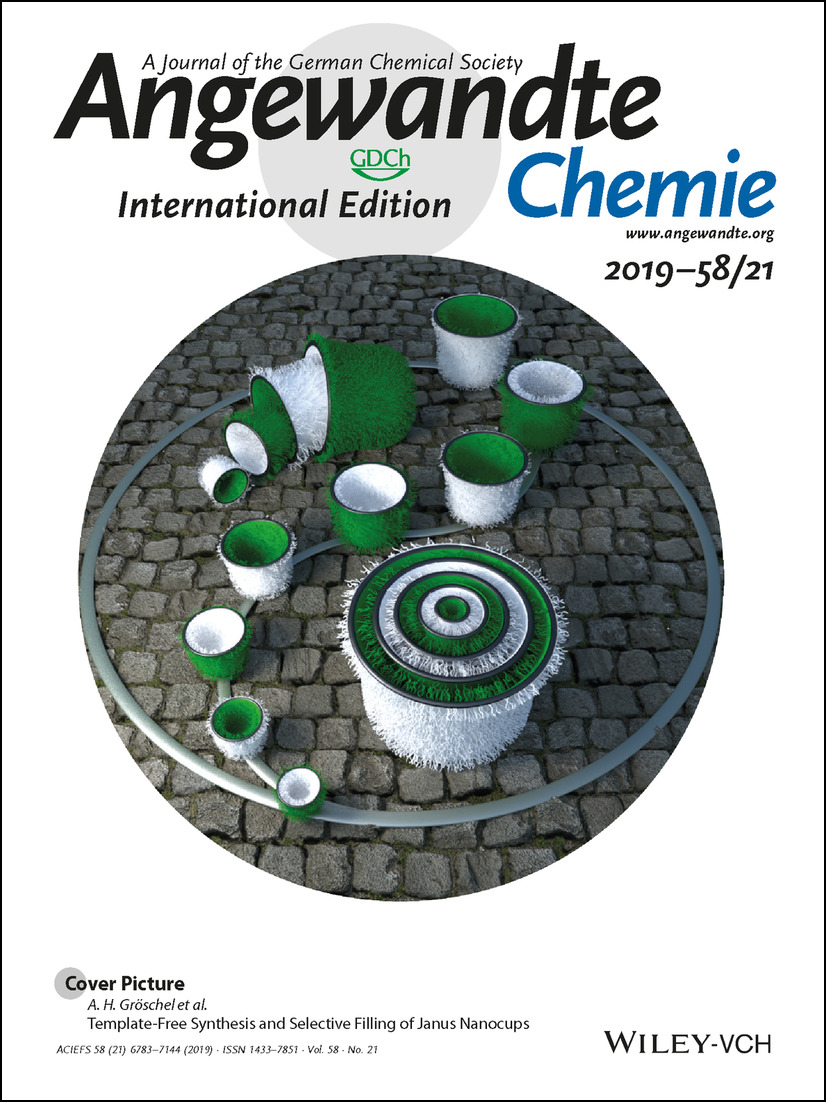
Janus nanocups … with attoliter volume and strictly different chemistry on the inside and the outside allow selective storage of molecular components as well as the capture of nanoparticles. In their Communication on page 7122 ff., A. H. Gröschel and co-workers present a synthetic route to Janus nanocups from ABC triblock terpolymers and investigate their properties.
Inside Cover: MOF-on-MOF: Oriented Growth of Multiple Layered Thin Films of Metal–Organic Frameworks (Angew. Chem. Int. Ed. 21/2019)
- Page: 6784
- First Published: 02 May 2019

Fully oriented and functional MOF-on-MOF films were achieved by epitaxial growth in solution. In their Communication on page 6886 ff., M. Takahashi, C. J. Doonan, and co-workers exploited the alignment of MOF multilayer films on an oriented Cu(OH)2 film. Ag nanoparticles accommodated in aligned pores with anisotropic shape in the selective layer of MOF-on-MOF film showed unique anisotropic plasmon resonances.
Inside Back Cover: All-Fullerene Electron Donor–Acceptor Conjugates (Angew. Chem. Int. Ed. 21/2019)
- Page: 7143
- First Published: 02 May 2019
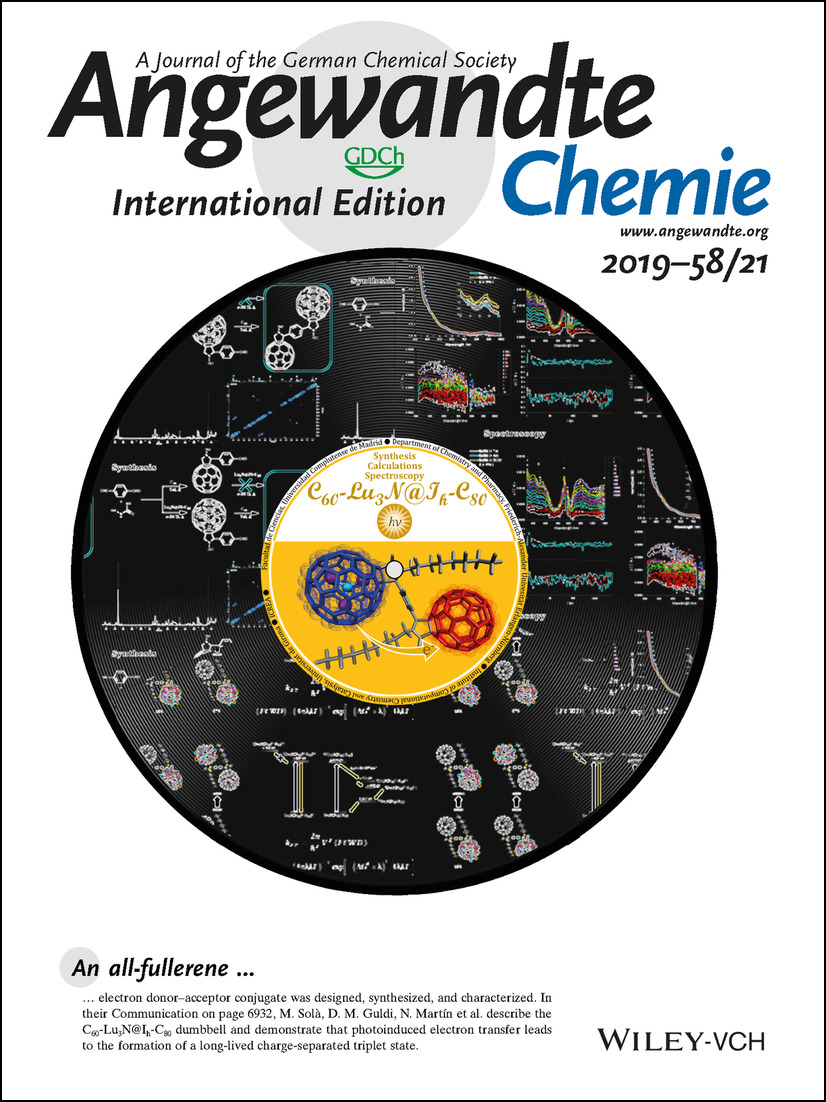
An all-fullerene electron donor–acceptor conjugate was designed, synthesized, and characterized. In their Communication on page 6932, M. Solà, D. M. Guldi, N. Martín et al. describe the C60-Lu3N@Ih-C80 dumbbell and demonstrate that photoinduced electron transfer leads to the formation of a long-lived charge-separated triplet state.
Back Cover: A Stable, Non-Corrosive Perfluorinated Pinacolatoborate Mg Electrolyte for Rechargeable Mg Batteries (Angew. Chem. Int. Ed. 21/2019)
- Page: 7144
- First Published: 10 April 2019
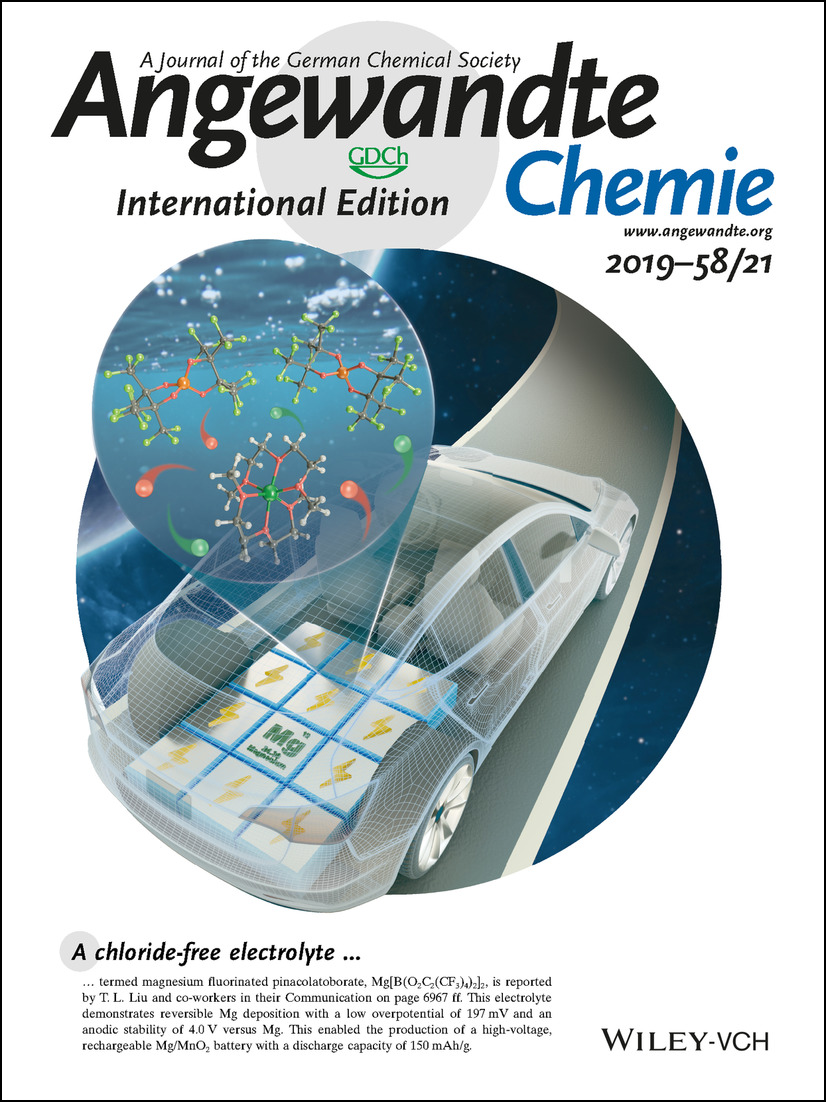
A chloride-free electrolyte termed magnesium fluorinated pinacolatoborate, Mg[B(O2C2(CF3)4)2]2, is reported by T. L. Liu and co-workers in their Communication on page 6967 ff. This electrolyte demonstrates reversible Mg deposition with a low overpotential of 197 mV and an anodic stability of 4.0 V versus Mg. This enabled the production of a high-voltage, rechargeable Mg/MnO2 battery with a discharge capacity of 150 mAh/g.
Frontispiece
Frontispiece: Tumor-Microenvironment-Induced Degradation of Ultrathin Gadolinium Oxide Nanoscrolls for Magnetic-Resonance-Imaging-Monitored, Activatable Cancer Chemotherapy
- First Published: 13 May 2019
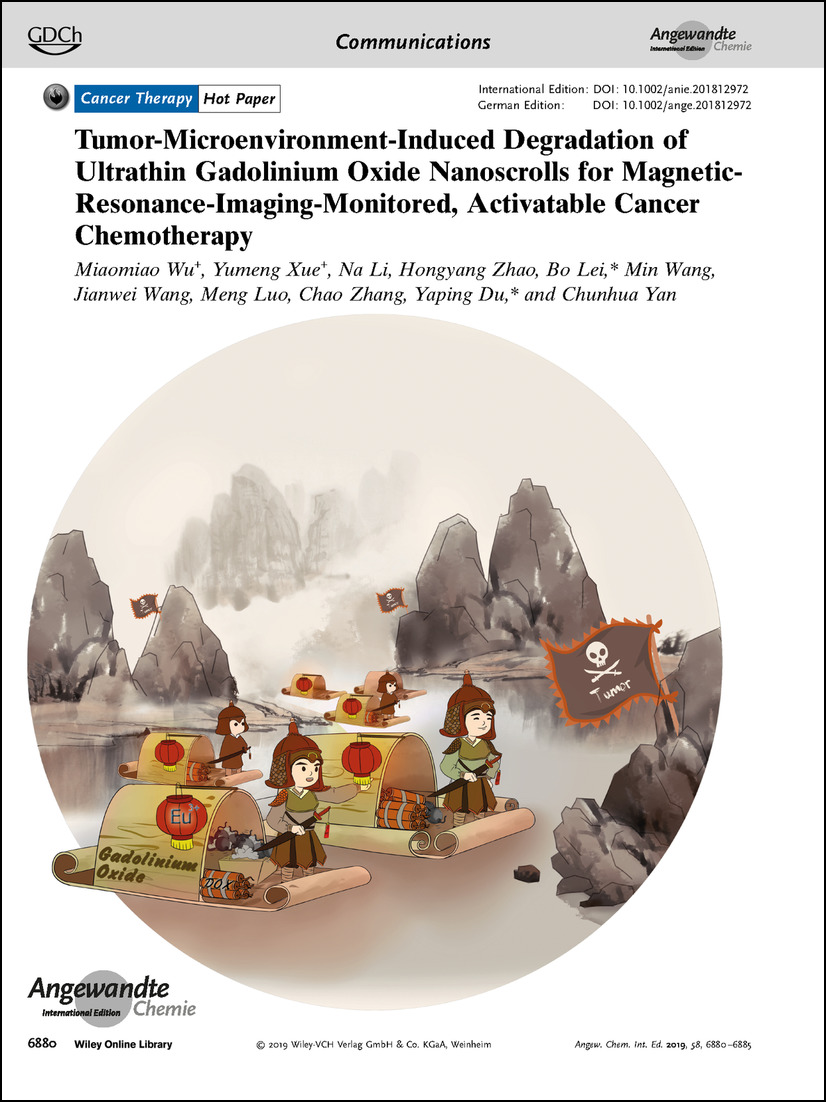
Cancer Therapy In their Communication on page 6880 ff., Y. P. Du, B. Lei, and co-workers report the use of Gd2O3 nanoscrolls, which biodegrade upon reaching the tumor microenvironment, for the targeted delivery of anticancer agents.
Graphical Abstract
Graphical Abstract: Angew. Chem. Int. Ed. 21/2019
- Pages: 6787-6802
- First Published: 13 May 2019
News
Spotlights on our sister journals: Angew. Chem. Int. Ed. 21/2019
- Pages: 6804-6808
- First Published: 13 May 2019
Author Profile
News
DECHEMA Prize: D. Rother / DECHEMA Early-Career Researcher Prize: P. Stallforth / NCK Prize: D. Margulies
- Page: 6812
- First Published: 17 April 2019
Highlights
Cross-Coupling
Acid Fluorides in Transition-Metal Catalysis: A Good Balance between Stability and Reactivity
- Pages: 6814-6817
- First Published: 09 April 2019
Minireviews
Organocatalysis
Enantioselective Carbonyl Catalysis Enabled by Chiral Aldehydes
- Pages: 6818-6825
- First Published: 14 September 2018
Atmospheric Chemistry
Use of Isotope Effects To Understand the Present and Past of the Atmosphere and Climate and Track the Origin of Life
- Pages: 6826-6844
- First Published: 11 January 2019
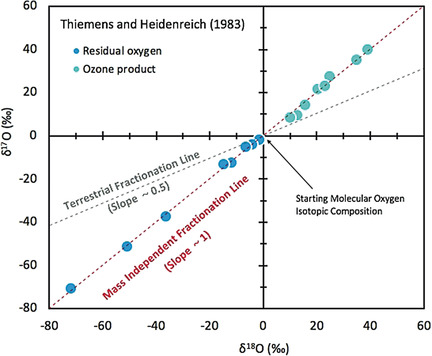
Mass-independent isotope effect is a new type of isotopic chemistry that does not follow the traditional isotope fractionation rule. It has been widely used in understanding the origin and evolutions of our solar system, Earth, Mars, life, and modern Earth's atmospheric and environmental physics and chemistry. This Minireview presents the history and most recent advances on this isotope effect, from quantum level understanding to its application in nature.
Reviews
Biosynthesis
Enzymatic Cascade Reactions in Biosynthesis
- Pages: 6846-6879
- First Published: 28 August 2018
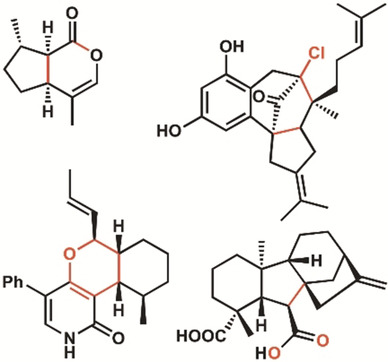
Fantastic four: Generally, enzymes are highly selective catalysts for single reactions. However, some enzymes instead control a series of reactions in a cascade-like fashion. This Review highlights four types of enzymatic cascade strategies, mediated by nucleophilic, electrophilic, pericyclic, and radical-based reactions, observed in the biosynthesis of complex natural products
Communications
Cancer Therapy | Hot Paper
Tumor-Microenvironment-Induced Degradation of Ultrathin Gadolinium Oxide Nanoscrolls for Magnetic-Resonance-Imaging-Monitored, Activatable Cancer Chemotherapy
- Pages: 6880-6885
- First Published: 25 January 2019
Metal–Organic Frameworks
MOF-on-MOF: Oriented Growth of Multiple Layered Thin Films of Metal–Organic Frameworks
- Pages: 6886-6890
- First Published: 29 March 2019
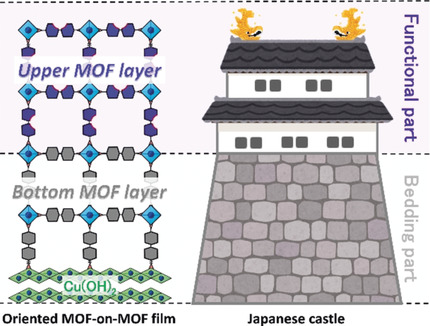
The precise alignment of multiple layers of metal–organic framework (MOF) thin films, or MOF-on-MOF films, over macroscopic length scales is presented. The MOF-on-MOF films are fabricated by epitaxially matching the interface. This strategy allows the synthesis of aligned MOF films that cannot be grown on a Cu(OH)2 surface.
Water Splitting Reaction
Enhanced Photoelectrochemical Water Splitting through Bismuth Vanadate with a Photon Upconversion Luminescent Reflector
- Pages: 6891-6895
- First Published: 01 April 2019

A luminescent back reflector (LBR) capable of photon upconversion (UC) is used to improve the light harvesting of Mo:BiVO4 photoelectrodes. The LBR converts the wavelengths of 600–650 nm and 350–450 nm into a wavelength that can be absorbed by a Mo:BiVO4 photoelectrode. Mo:BiVO4/LBR exhibits a photocurrent density of 5.25 mA cm−2 at 1.23 V versus the reversible hydrogen electrode.
Nonlinear Optical Materials
Nonlinear Optical Switching in Regioregular Porphyrin Covalent Organic Frameworks
- Pages: 6896-6900
- First Published: 12 March 2019

COF it up! Three regioregular porphyrin-based porous covalent organic frameworks (COFs) with excellent nonlinear optical (NLO) properties are presented. Por-COF-HH and its metalated congeners, Por-COF-ZnCu and Por-COF-ZnNi, were prepared by Schiff base condensation of tetrasubstituted porphyrin aldehydes and amines. The NLO switching and high-parameter values obtained for these Por-COFs are promising for optical switching and optical limiting devices.
Electrochemiluminescence
Efficient and Monochromatic Electrochemiluminescence of Aqueous-Soluble Au Nanoclusters via Host–Guest Recognition
- Pages: 6901-6905
- First Published: 03 April 2019
Enzyme Engineering
An Engineered Aryl Acid Adenylation Domain with an Enlarged Substrate Binding Pocket
- Pages: 6906-6910
- First Published: 03 April 2019
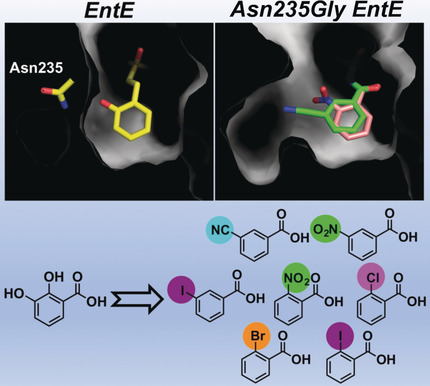
What has it got in its pocketses? A single asparagine-to-glycine mutation in the aryl acid adenylation domain EntE gives a novel promiscuous enzyme that accepts a range of non-native substrates, in particular, aryl acids functionalized with cyano, nitro, bromo, and iodo groups. Co-crystal structures with non-hydrolysable aryl-AMP analogues revealed the origins of the substrate promiscuity to be an enlarged active-site pocket.
Fluorescent Probes | Hot Paper
SCOTfluors: Small, Conjugatable, Orthogonal, and Tunable Fluorophores for In Vivo Imaging of Cell Metabolism
- Pages: 6911-6915
- First Published: 28 March 2019
Surface Chemistry
Origin of Thermal and Hyperthermal CO2 from CO Oxidation on Pt Surfaces: The Role of Post-Transition-State Dynamics, Active Sites, and Chemisorbed CO2
- Pages: 6916-6920
- First Published: 12 March 2019
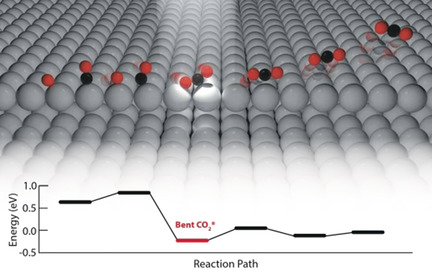
Mind the step! DFT-based ab initio molecular dynamics studies reveal the origin of the experimentally observed bimodal CO2 velocity distribution on Pt surfaces. While CO2 formed at terrace sites desorbs directly with high velocities, it is trapped in a chemisorption well when formed at step sites. This is due to an electron transfer to an antibonding CO2 orbital and leads to a desorption with low velocities and a broader angular distribution.
Supramolecular Chemistry
Repositioning Chloride Transmembrane Transporters: Transport of Organic Ion Pairs
- Pages: 6921-6925
- First Published: 29 March 2019

Chloride carriers as cotransporters for organic ion pairs: Calix[6]arene tris(thio)ureas, bearing a cavity that can accommodate primary ammonium ions, can perform the cotransport of PrNH3Cl across a lipid bilayer, as well as Cl−/NO3− antiport. The advantage of the cavity is highlighted by comparing calixarenes to receptors without a cavity, and by attempting to transport bulkier alkylammonium ions, which cannot be complexed in the cavity.
Phosphohalides
Structural Features and HER activity of Cadmium Phosphohalides
- Pages: 6926-6931
- First Published: 25 March 2019
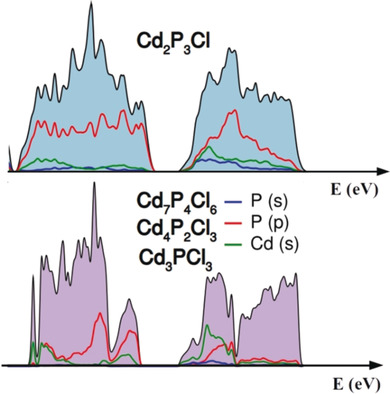
The right alignment: The structural and electronic properties of cadmium phosphochlorides were investigated experimentally and using density-functional-theory calculations. The positions of the valence band maxima and conduction band minima allow these systems to be used in the hydrogen evolution reaction.
Fullerenes
All-Fullerene Electron Donor–Acceptor Conjugates
- Pages: 6932-6937
- First Published: 05 March 2019
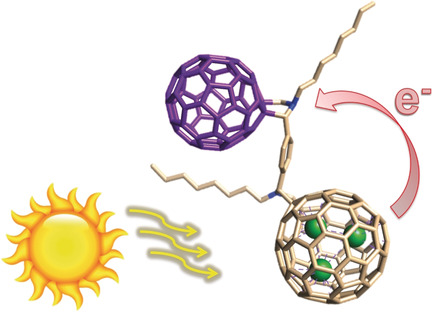
Dumbbell charge transfer: The synthesis of an all-fullerene electron donor–acceptor conjugate, C60-Lu3N@Ih-C80, is reported. In the dumbbell-like system, one fullerene moiety acts as the donor (Lu3N@Ih-C80) while the other acts as the acceptor (C60). Spin conversion of the charge-separated singlet state into the corresponding triplet state slows down the charge recombination by one order of magnitude.
Low-Coordinate Co Complexes
A Low-Spin Three-Coordinate Cobalt(I) Complex and Its Reactivity toward H2 and Silane
- Pages: 6938-6942
- First Published: 18 March 2019
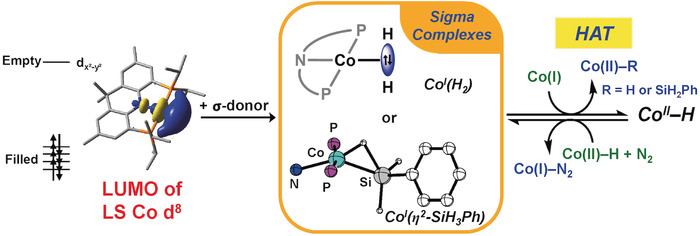
Fits to a T: A three-coordinate low-spin cobalt(I) complex with an acridane-based pincer ligand was synthesized. It reacts with H2 and PhSiH3 by σ-complexation at the cobalt center, which has an empty  orbital. In this example, the homolysis of a σ-bond by bimolecular hydrogen atom transfer (HAT) occurs rather than oxidative addition.
orbital. In this example, the homolysis of a σ-bond by bimolecular hydrogen atom transfer (HAT) occurs rather than oxidative addition.
Perovskite Quantum Dots
Full-Spectrum Persistent Luminescence Tuning Using All-Inorganic Perovskite Quantum Dots
- Pages: 6943-6947
- First Published: 27 March 2019
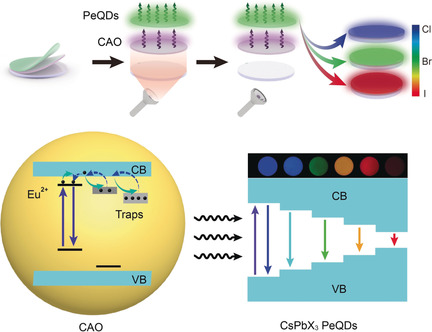
A unique and versatile strategy is proposed to fine-tune the persistent luminescence over the entire visible spectral region with narrow bandwidth and highly synchronized afterglow decay. It uses a CaAl2O4:Eu2+,Nd3+ (CAO) afterglow phosphor as the single energy storage source and all-inorganic CsPbX3 (X=Cl, Br, and I) perovskite quantum dots (PeQDs) as efficient light conversion materials.
Nanostructures
Orthogonally Photocontrolled Non-Autonomous DNA Walker
- Pages: 6948-6951
- First Published: 21 March 2019
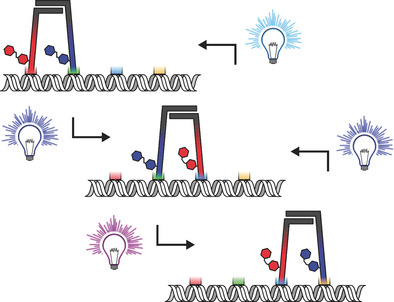
Walking on sunshine: A non-autonomous DNA walker can processively move two steps back and forth on a defined path and is powered exclusively by light irradiation in an orthogonal fashion. Irradiation at different wavelengths, in a defined sequence, leads to precise control over the motion and position of the walker at every step. The non-invasive regulation of multistep processive motion is the first critical achievement towards nanoscale robotics.
Luminescence
Circularly-Polarized Electrochemiluminescence from a Chiral Bispyrene Organic Macrocycle
- Pages: 6952-6956
- First Published: 27 March 2019
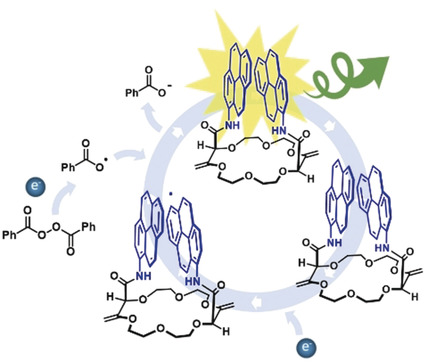
A polarizing pair: Circularly polarized electrochemiluminescence from a chiral organic molecule is observed. The macrocyclic scaffold leads to an efficient excimer formation between two pyrene moieties that are covalently attached. As a result, highly polarized emission is obtained upon electrochemical excitation.
Organocatalysis
Phenanthroline-Catalyzed Stereoretentive Glycosylations
- Pages: 6957-6961
- First Published: 28 March 2019
Lithium Peroxide
Isotopic Labeling Reveals Active Reaction Interfaces for Electrochemical Oxidation of Lithium Peroxide
- Pages: 6962-6966
- First Published: 23 March 2019
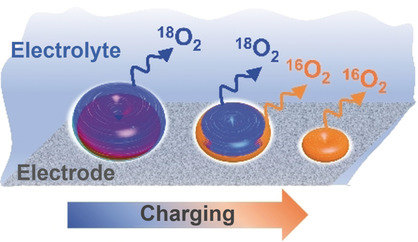
Face time: Isotopically labelled microsized Li2O2 particles with an Li216O2/electrode interface and Li218O2/electrolyte interface were fabricated. On-line electrochemical mass spectroscopy showed that upon Li2O2 oxidation 18O2 was evolved for the first quarter of the charge capacity followed by 16O2. These observations unambiguously demonstrate that oxygen loss starts at the Li2O2/electrolyte interface instead of the electrode/Li2O2 interface.
Batteries | Very Important Paper
A Stable, Non-Corrosive Perfluorinated Pinacolatoborate Mg Electrolyte for Rechargeable Mg Batteries
- Pages: 6967-6971
- First Published: 04 March 2019
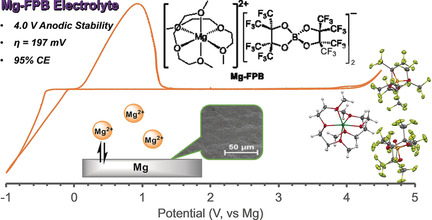
Electric youth: A stable, non-corrosive perfluorinated pinacolatoborate Mg electrolyte was developed for rechargeable Mg battery applications. This electrolyte has a Coulombic efficiency of 95 % and an overpotential of 197 mV, enabling reversible Mg deposition, and an anodic stability of up to 4.0 V vs. Mg. This was used to produce a high voltage, rechargeable Mg/MnO2 battery with a discharge capacity of 150 mAh g−1.
Electrocatalysis
Isolated Diatomic Ni-Fe Metal–Nitrogen Sites for Synergistic Electroreduction of CO2
- Pages: 6972-6976
- First Published: 28 March 2019
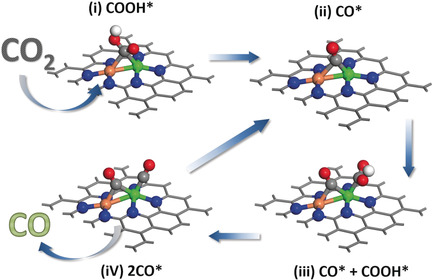
The collaborative coordination of CO at diatomic Ni-Fe sites anchored on nitrogenated carbon is the key to a new nickel–iron catalyst developed for the electroreduction of CO2. The catalyst achieves a high Faradaic efficiency of 98 % at −0.7 V, outstanding turnover frequency, and robust electrode durability.
Ultrathin Catalysts | Hot Paper
Unveiling the Layer-Dependent Catalytic Activity of PtSe2 Atomic Crystals for the Hydrogen Evolution Reaction
- Pages: 6977-6981
- First Published: 28 March 2019

Through thick and thin: Since the thickness of two-dimensional (2D) PtSe2 flakes can be controlled by adjusting synthesis conditions, their layer-dependent catalytic activity for the hydrogen evolution reaction could be investigated from both theoretical and experimental perspectives. Structure–activity correlations were drawn, providing new insights for the design and synthesis of ultrathin catalysts.
Luminescence
Persistent Solid-State Phosphorescence and Delayed Fluorescence at Room Temperature by a Twisted Hydrocarbon
- Pages: 6982-6986
- First Published: 25 March 2019
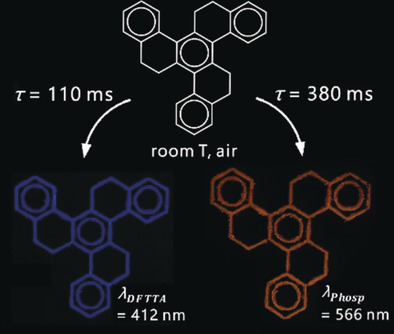
Twist and shine: Homotruxene, a non-planar arene, was obtained by trimerization of 1-tetralone. Due to its geometry, the molecule possesses unique luminescence properties for a pure hydrocarbon: pronounced spin–orbit coupling and a high triplet energy lead to room-temperature phosphorescence, while triplet–triplet annihilation causes a substantial delayed fluorescence.
Drug Delivery
A Biocompatible Heterogeneous MOF–Cu Catalyst for In Vivo Drug Synthesis in Targeted Subcellular Organelles
- Pages: 6987-6992
- First Published: 19 March 2019
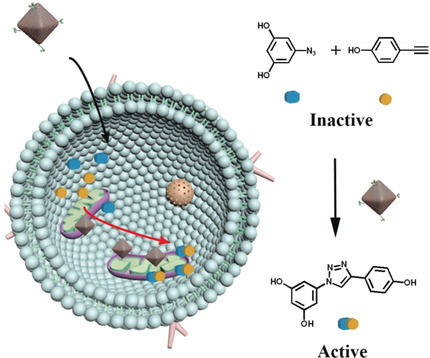
Hit the spot: A copper-functionalized triphenylphosphonium-modified metal–organic framework catalyzed localized drug synthesis in mitochondria through a site-specific copper-catalyzed azide–alkyne cycloaddition (CuAAC) reaction (see picture). This system has wide applicability for the in situ synthesis of drugs with good biocompatibility and has unique advantages for improving the efficacy of active drugs and avoiding side effects.
Main-Group Elements
Validating the Biphilic Hypothesis of Nontrigonal Phosphorus(III) Compounds
- Pages: 6993-6998
- First Published: 22 March 2019
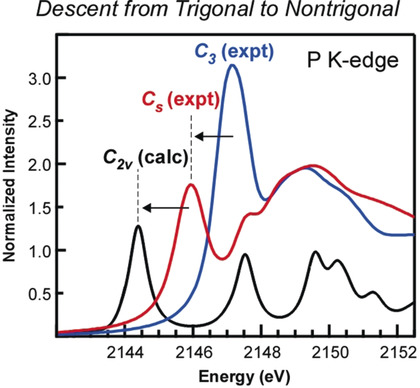
Double agent: P K-edge XANES and TDDFT calculations were used to quantify how nontrigonal structural deformations affect the electronic structure and reactivity of a series of P(NNN) compounds. The results suggest that biphilic PIII reactivity reported previously with and without a transition-metal host stems from a common low-lying phosphorus-based acceptor orbital that becomes energetically accessible in response to nontrigonal PIII distortions.
Electrochemistry | Hot Paper
Asymmetric Lewis Acid Catalyzed Electrochemical Alkylation
- Pages: 6999-7003
- First Published: 25 March 2019

Electrifying: An efficient asymmetric electrosynthesis was developed with high yields and excellent enantioselectivities by using a chiral Ni catalyst. Mechanistic studies suggest that the Lewis-acid-bound radical intermediate, from a single-electron anodic oxidation, selectively reacts with a benzylic radical species to generate the desired adducts.
Natural Products
The Furan Shuffling Hypothesis: A Biogenetic Proposal for Eremophilane Sesquiterpenoids
- Pages: 7004-7007
- First Published: 22 March 2019
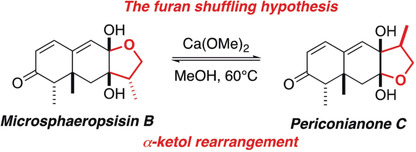
Shuffle the rings: An unusual furan rearrangement biogenetically connecting the eremophilane natural product microsphaeropsisin B and its regioisomer periconianone C is postulated. Strong experimental support for this intriguing mechanistic pattern is provided by total synthesis, with an α-ketol rearrangement.
Polymer Dots | Very Important Paper
A BODIPY-Based Donor/Donor–Acceptor System: Towards Highly Efficient Long-Wavelength-Excitable Near-IR Polymer Dots with Narrow and Strong Absorption Features
- Pages: 7008-7012
- First Published: 25 March 2019
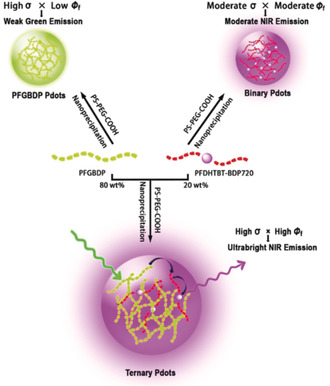
Bright lights, small dots: Achieving long-wavelength-excitable near-infrared semiconducting polymer dots with simultaneously high fluorescence quantum yield, strong absorption cross-section, narrow absorption-emission bandwiths, and large Stokes shift by employing a BODIPY-based donor/donor-acceptor system.
Charge Transfer
Enhanced Circularly Polarized Luminescence in Emissive Charge-Transfer Complexes
- Pages: 7013-7019
- First Published: 01 April 2019
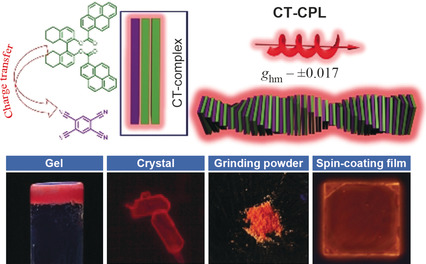
Circularly polarized luminescence of charge-transfer complexes was demonstrated for the first time. The complexes feature a large glum value owing to charge-transfer interactions. Benefiting from the large magnetic dipole transition moment in the charge-transfer state, the CPL activity of mixed-stack CT complexes exhibited large circular polarization.
Lithium-Ion Batteries | Very Important Paper
Cyclohexanehexone with Ultrahigh Capacity as Cathode Materials for Lithium-Ion Batteries
- Pages: 7020-7024
- First Published: 27 March 2019

Six pack: Cyclohexanehexone (C6O6) is synthesized and applied as a cathode material in lithium-ion batteries that exhibit an ultrahigh capacity of 902 mA h g−1 (1533 Wh kg−1). As a result of its limited dissolution, C6O6 shows relatively good cycling stability (a capacity retention of 82 % after 100 cycles at 50 mA g−1) in ionic liquid electrolyte.
Hydroboration
Magnesium-Catalyzed Hydroboration of Terminal and Internal Alkynes
- Pages: 7025-7029
- First Published: 12 April 2019
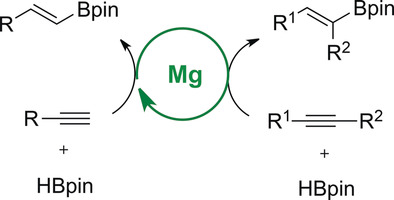
MgBu2 proved to be an efficient catalyst for the hydroboration of terminal and internal alkynes, achieving good yields and selectivities. The compatibility with many functional groups makes the Mg-catalyzed hydroboration of alkynes very attractive as a late stage functionalization procedure. Moreover, experimental investigations together with DFT calculations provide insight into the reaction mechanism.
Olefin Polymerization
Significant Polar Comonomer Enchainment in Zirconium-Catalyzed, Masking Reagent-Free, Ethylene Copolymerizations
- Pages: 7030-7034
- First Published: 26 March 2019
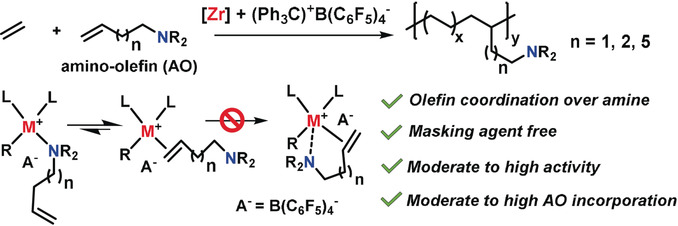
Masking reagent-free: Organozirconium-catalyzed copolymerization of ethylene with polar amino-olefins proceeds with high activity and high polar monomer incorporation in the absence of a masking reagent. Experimental and DFT mechanistic analysis show that the high activity is attributable to favorable olefin over amino group coordination.
Oxygen Reduction Reaction | Hot Paper
Ultrahigh-Loading Zinc Single-Atom Catalyst for Highly Efficient Oxygen Reduction in Both Acidic and Alkaline Media
- Pages: 7035-7039
- First Published: 20 March 2019
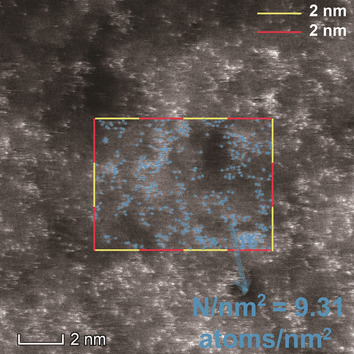
Slow and steady wins the race: An atomically dispersed Zn–N–C catalyst with an ultrahigh loading of single Zn atoms of 9.33 wt % (see HAADF-STEM image) was successfully prepared by decreasing the annealing rate to 1° min−1. The Zn–N–C catalyst exhibited comparable ORR activity to that of the corresponding Fe–N–C catalyst, and greater ORR stability in both acidic and alkaline media.
Photoluminescence
Hydrogen Peroxide Assisted Synthesis of Highly Luminescent Sulfur Quantum Dots
- Pages: 7040-7044
- First Published: 28 March 2019
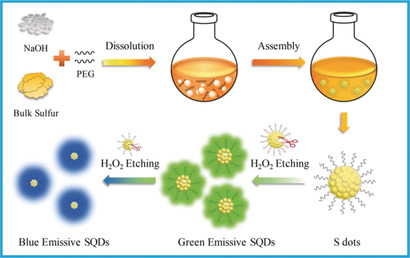
An H2O2-assisted top-down approach was proposed to synthesize brightly luminescent sulfur quantum dots (SQDs), which allows simultaneous control over the final size, tuning of their emission color, and improving their emission quantum yield (up to 23 %) by eliminating surface traps. White light emitting diodes using blue emissive SQDs and orange emissive copper nanoclusters are also demonstrated.
Electrolytes
Biredox Eutectic Electrolytes Derived from Organic Redox-Active Molecules: High-Energy Storage Systems
- Pages: 7045-7050
- First Published: 01 April 2019
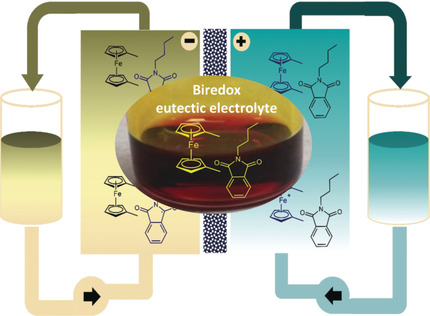
Busy BEE: A biredox eutectic electrolyte (BEE) is derived from the intermolecular interactions between the redox-active molecules N-butylphthalimide and 1,1-dimethylferrocene. Given the high concentration of active materials, the flow cell based on the BEE delivers stable cycling performance, and high volumetric capacity and power density. The facile and effective strategy has potential for high-performance nonaqueous redox flow batteries for high-energy storage systems.
Metal–Organic Frameworks
Large-Scale, Bottom-Up Synthesis of Binary Metal–Organic Framework Nanosheets for Efficient Water Oxidation
- Pages: 7051-7056
- First Published: 26 March 2019
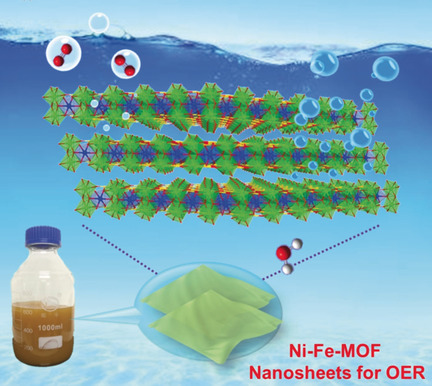
Ultrathin, binary MOF nanosheets (NSs) have been successfully prepared for the first time and directly used as efficient oxygen evolution reaction (OER) catalysts. The binary MOF NSs exhibit a highly composition-dependent OER activity. The optimized Ni–Fe–MOF NSs are highly active and stable towards the OER.
Amorphous Materials
Quantifying Chemical Structure and Machine-Learned Atomic Energies in Amorphous and Liquid Silicon
- Pages: 7057-7061
- First Published: 05 March 2019
Rechargeable Batteries
Reversible Oxygen Redox Chemistry in Aqueous Zinc-Ion Batteries
- Pages: 7062-7067
- First Published: 20 March 2019
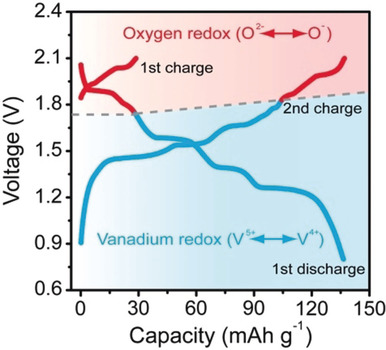
Rezinking zinc batteries: Aqueous zinc-ion batteries based on VOPO4 cathodes and a water-in-salt electrolyte displayed highly reversible oxygen redox chemistry at high voltages (see graph). The oxygen redox process not only led to increased capacity and a higher average operating voltage of the Zn/VOPO4 batteries, but also improved rate capability and cycling performance.
Heterogeneous Catalysis
Reversible Nature of Coke Formation on Mo/ZSM-5 Methane Dehydroaromatization Catalysts
- Pages: 7068-7072
- First Published: 22 March 2019
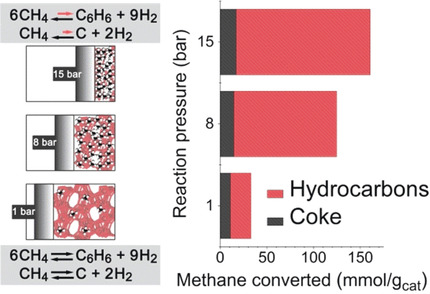
Under pressure Mo/ZSM-5 catalysts display much better methane dehydroaromatization performance in a wide range of conditions. An eightfold increase in aromatic productivity is obtained by increasing the reaction pressure from 1 to 15 bar. These findings are rationalized by the reversible growth of coke species and better utilization of the zeolite micropores.
Fluorescent Probes
A Photoexcitation-Induced Twisted Intramolecular Charge Shuttle
- Pages: 7073-7077
- First Published: 27 March 2019
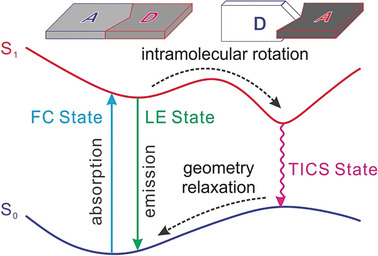
Twisted intramolecular charge shuttle (TICS): In TICS systems, the donor and acceptor moieties dynamically switch roles in the excited state due to an approximately 90° intramolecular rotation that is induced upon photoexcitation. This results in charge shuttling. TICSs exist in several families of fluorophores and could be utilized in the construction of fluorescent probes.
Nanocomposites
Aqueous Stable Gold Nanostar/ZIF-8 Nanocomposites for Light-Triggered Release of Active Cargo Inside Living Cells
- Pages: 7078-7082
- First Published: 21 March 2019
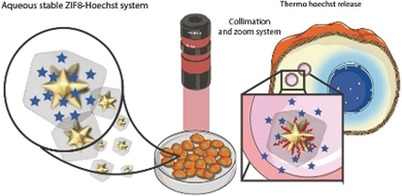
Triggered release: A thermoresponsive carrier comprising gold nanostars coated with ZIF-8 stabilized with an amphiphilic polymer was developed for the light-triggered release of encapsulated cargo inside cells. This nanocomposite, which is stable in aqueous solution (even when stored in cells), combines thermoplasmonic and high drug-loading capabilities.
Methane Conversion
Direct Non-Oxidative Methane Conversion in a Millisecond Catalytic Wall Reactor
- Pages: 7083-7086
- First Published: 18 March 2019
Imaging
Membrane-Penetrating Carbon Quantum Dots for Imaging Nucleic Acid Structures in Live Organisms
- Pages: 7087-7091
- First Published: 26 March 2019
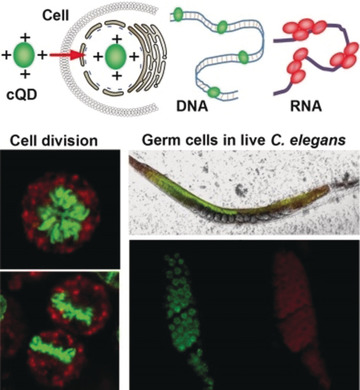
Connect the dots: A cationic carbon quantum dot (cQD) probe emits spectrally distinguishable fluorescence signals upon binding to DNA (green) and RNA (red) in live cells, thereby enabling real-time imaging of DNA and RNA localization and motion. The probe can penetrate through various types of biological barriers in cells and in vivo for super-resolution microscopy and time-lapse imaging of chromatin and nucleoli during cell division and C. elegans growth.
Organocatalysis
Chiral Brønsted Acid Catalyzed Dynamic Kinetic Asymmetric Hydroamination of Racemic Allenes and Asymmetric Hydroamination of Dienes
- Pages: 7092-7096
- First Published: 27 March 2019
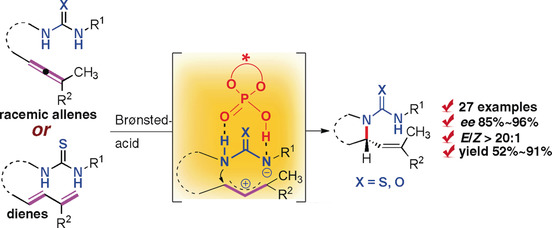
Model DyKAH: The first Brønsted acid catalyzed dynamic kinetic asymmetric hydroamination (DyKAH) of racemic allenes and asymmetric hydroamination of dienes with both high E/Z selectivity and enantioselectivity is presented. The transformation proceeds through a new catalytic asymmetric model involving a reactive π-allylic carbocationic intermediate. This method affords expedient access to diverse enantioenriched, bioactive aza-heterocycles.
Fluorination
Ligand-Promoted Iron(III)-Catalyzed Hydrofluorination of Alkenes
- Pages: 7097-7101
- First Published: 20 March 2019
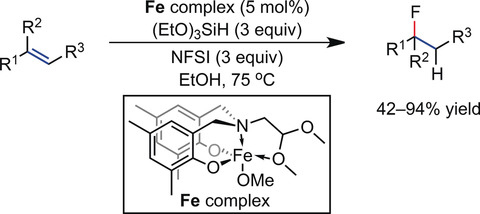
H(igh)–F(ive): The combination of a multidentate ligand, (EtO)3SiH, and N-fluorobenzenesulfonimide (NFSI) proved critical in facilitating an iron-catalyzed hydrofluorination of unactivated alkenes to provide a variety of substituted fluorinated compounds. The reaction was shown to proceed by a radical mechanism and to be suitable for the fluorination of various biologically active substrates.
Water Splitting
Polymeric Carbon Nitride/Reduced Graphene Oxide/Fe2O3: All-Solid-State Z-Scheme System for Photocatalytic Overall Water Splitting
- Pages: 7102-7106
- First Published: 28 March 2019
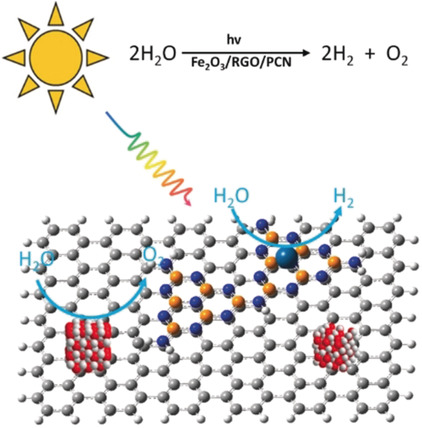
Improving charge transfer: A ternary heterojunction was designed, in which polymeric carbon nitride (PCN) and Fe2O3 served as the hydrogen evolution photocatalyst and the oxygen evolution photocatalyst, respectively, while reduced graphene oxide (RGO) acted as an electron transfer “freeway”. This all-solid-state Z-scheme system showed promising activity for photocatalytic stoichiometric water splitting under simulated sunlight irradiation.
Natural Product
Reassignments and Corroborations of Oxo-Bridged Natural Products Directed by OSE and DU8+ NMR Computation
- Pages: 7107-7112
- First Published: 24 April 2019
Polymers
Synthesis of Poly(N-vinylamide)s and Poly(vinylamine)s and Their Block Copolymers by Organotellurium-Mediated Radical Polymerization
- Pages: 7113-7116
- First Published: 28 March 2019
Allylic Amidation
Intermolecular, Branch-Selective, and Redox-Neutral Cp*IrIII-Catalyzed Allylic C−H Amidation
- Pages: 7117-7121
- First Published: 20 March 2019
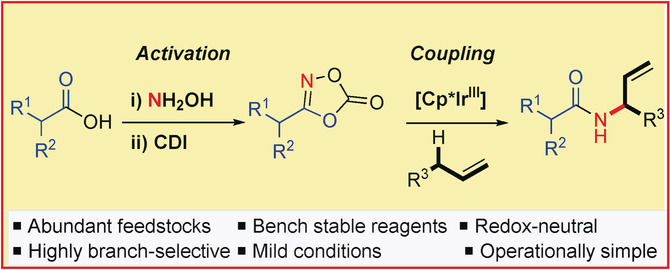
A new branch! A novel strategy for the mild, highly branch-selective and redox-neutral allylic C−H amidation is described. Naturally occurring and abundant carboxylic acids were converted into the corresponding dioxazolones and reliably coupled with terminal and internal olefins. The synthetic value of this transformation was demonstrated in the coupling of complex and bioactive scaffolds.
Janus Nanoparticles
Template-Free Synthesis and Selective Filling of Janus Nanocups
- Pages: 7122-7126
- First Published: 25 January 2019
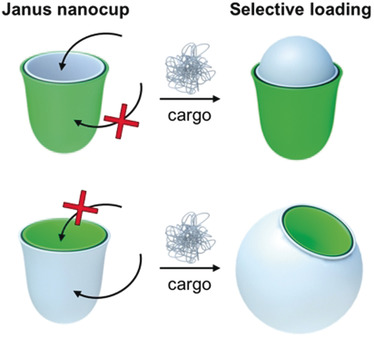
Filled to the brim: Two types of Janus nanocups were prepared from ABC triblock terpolymers through cross-linking and disassembly of shape-anisotropic “tulip-bulb” microparticles. Both nanocups feature mirrored Janus properties that allow selective filling of the cup interior or the exterior with compatible materials.
Enzyme Regulation
Tailored Peptide Phenyl Esters Block ClpXP Proteolysis by an Unusual Breakdown into a Heptamer–Hexamer Assembly
- Pages: 7127-7132
- First Published: 04 March 2019
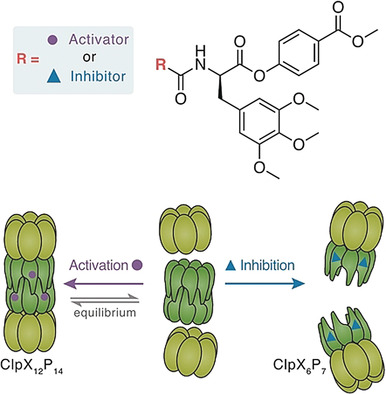
Tight and loose: Covalent (R)-amino acid modifiers are novel tools for probing the activity and oligomerization of the bacterial ClpXP protease. Substoichiometric binding strengthens the ClpX–ClpP interaction. Depending on the substitution of the compound, proteolysis is either stimulated or efficiently inhibited by formation of an unprecedented complex assembly.
Macromolecular Chemistry
Protection-Group-Free Synthesis of Sequence-Defined Macromolecules via Precision λ-Orthogonal Photochemistry
- Pages: 7133-7137
- First Published: 19 March 2019
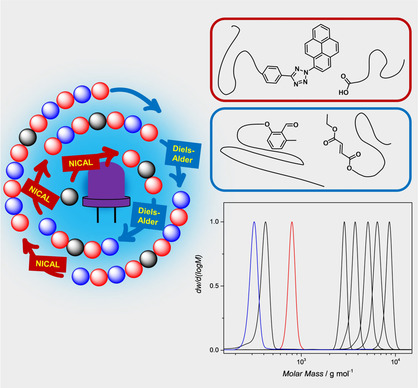
No protection needed: A strategy employing a highly efficient λ-orthogonal photochemical procedure by selective excitation of photosensitive groups paves the way to precision monodisperse sequence-defined linear macromolecules without any need for protection-group chemistry. The chain growth is based on a two-monomer system that enables protection group free convergent chain extension on-demand.
Peptide Design | Hot Paper
Identification of Chemokine Ligands by Biochemical Fragmentation and Simulated Peptide Evolution
- Pages: 7138-7142
- First Published: 07 March 2019
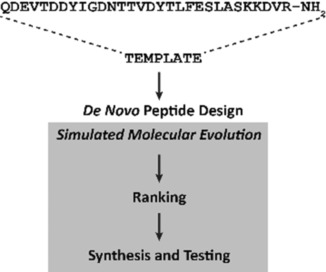
Fragmentation of the chemokine-receptor CCL19/CCR7 binding domain led to a hexapeptide as a template for de novo peptide design. Computer-generated peptides were characterized in terms of their binding to CCl19. Potent ligands were identified as starting points for developing innovative protein–protein interaction modulators.




